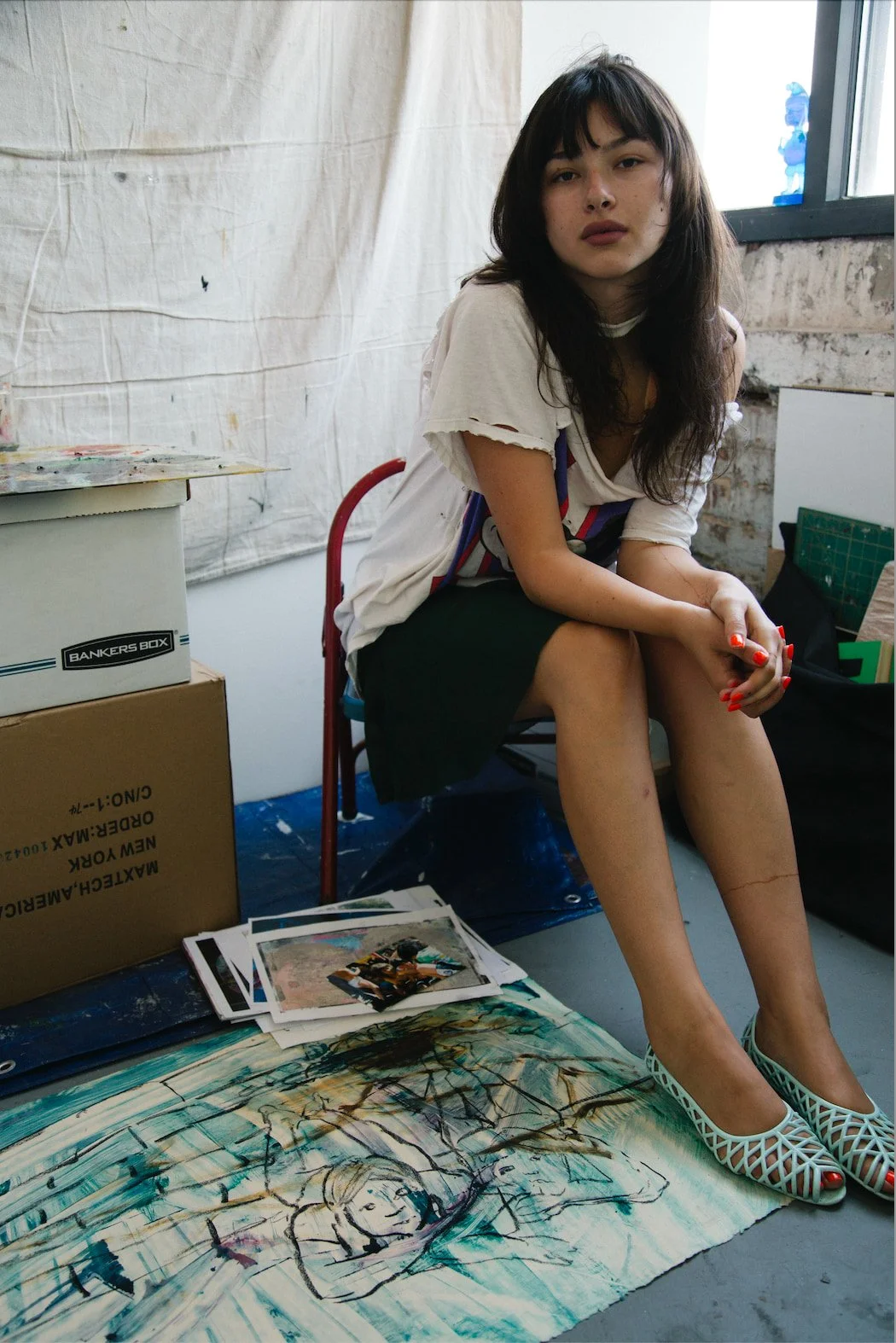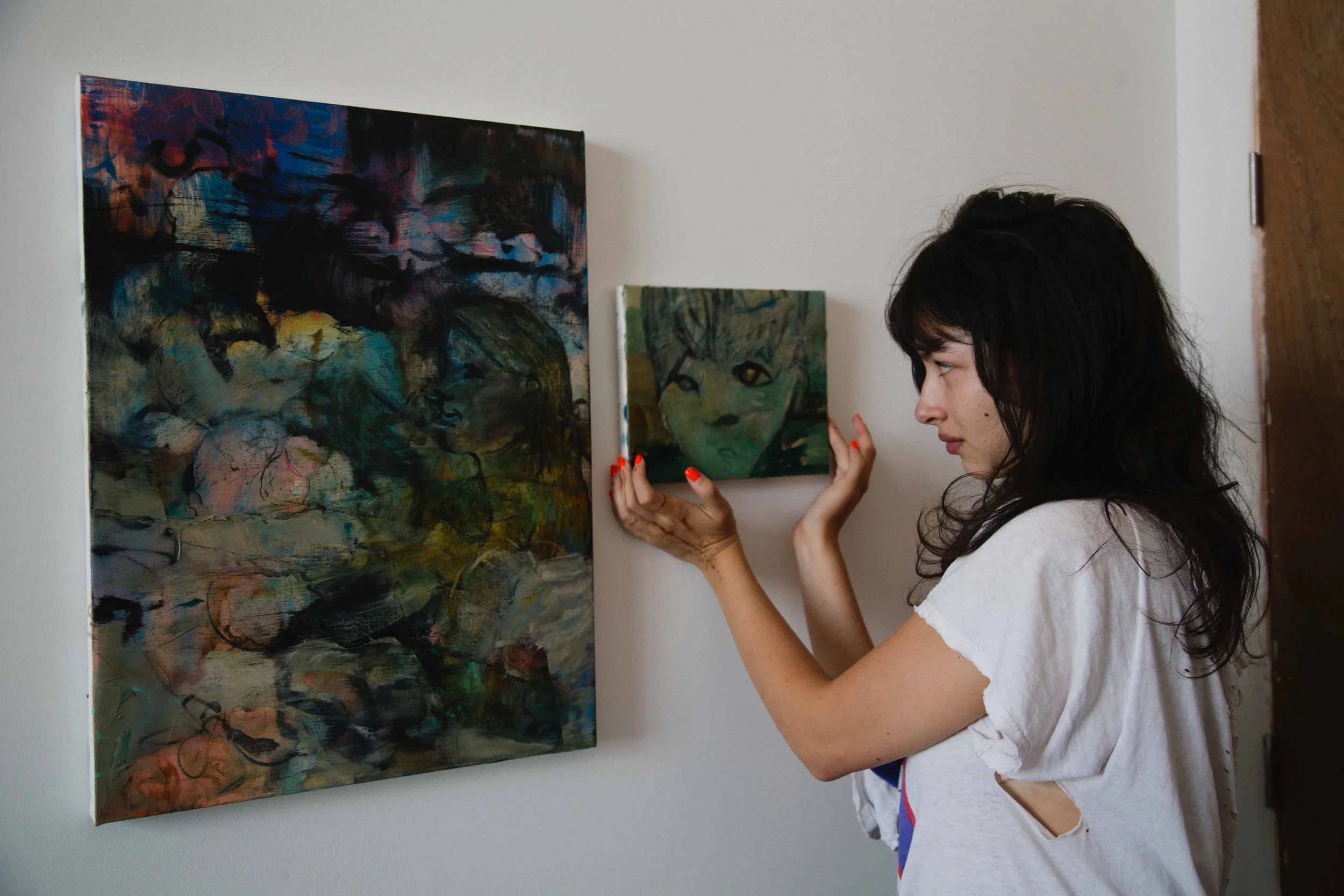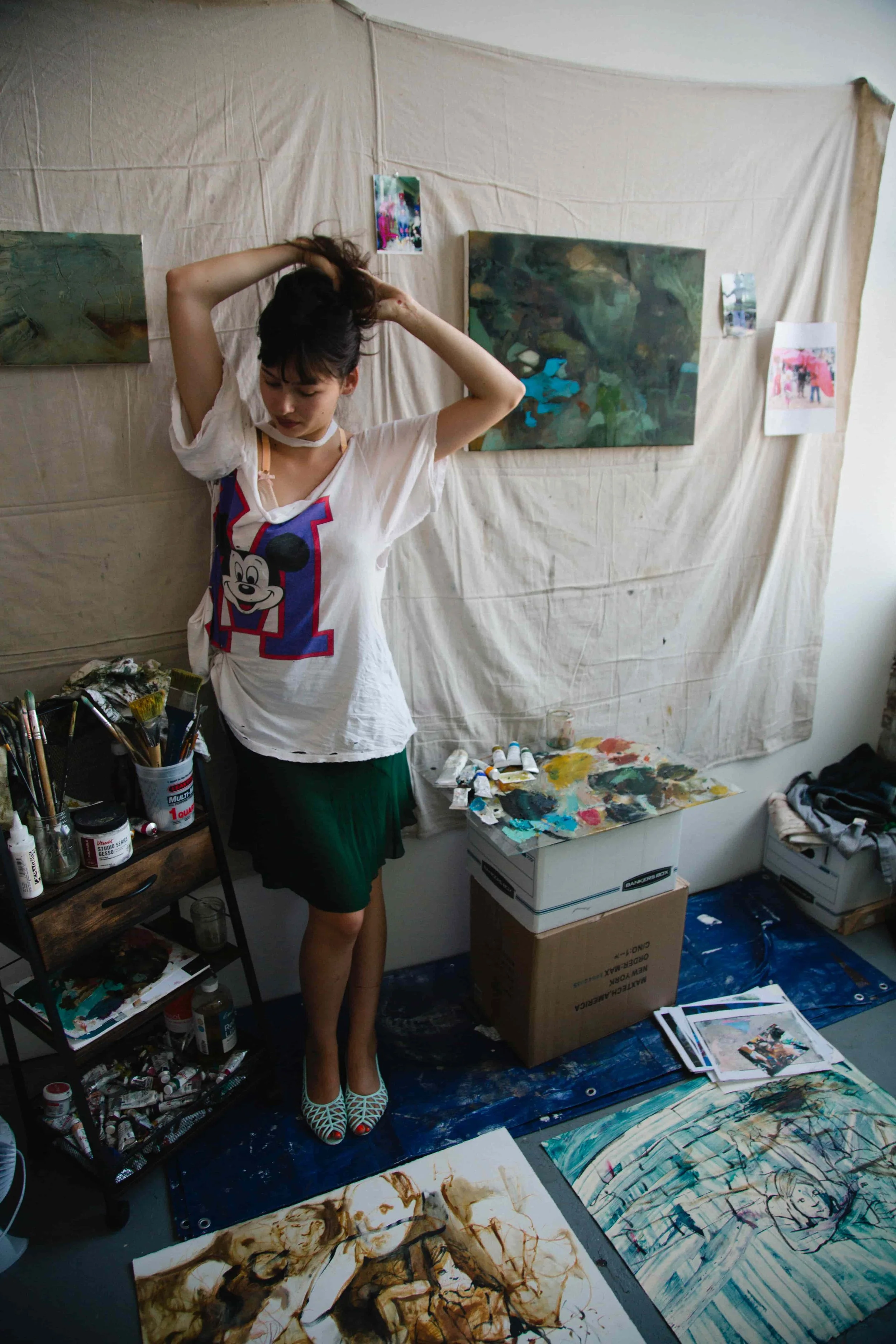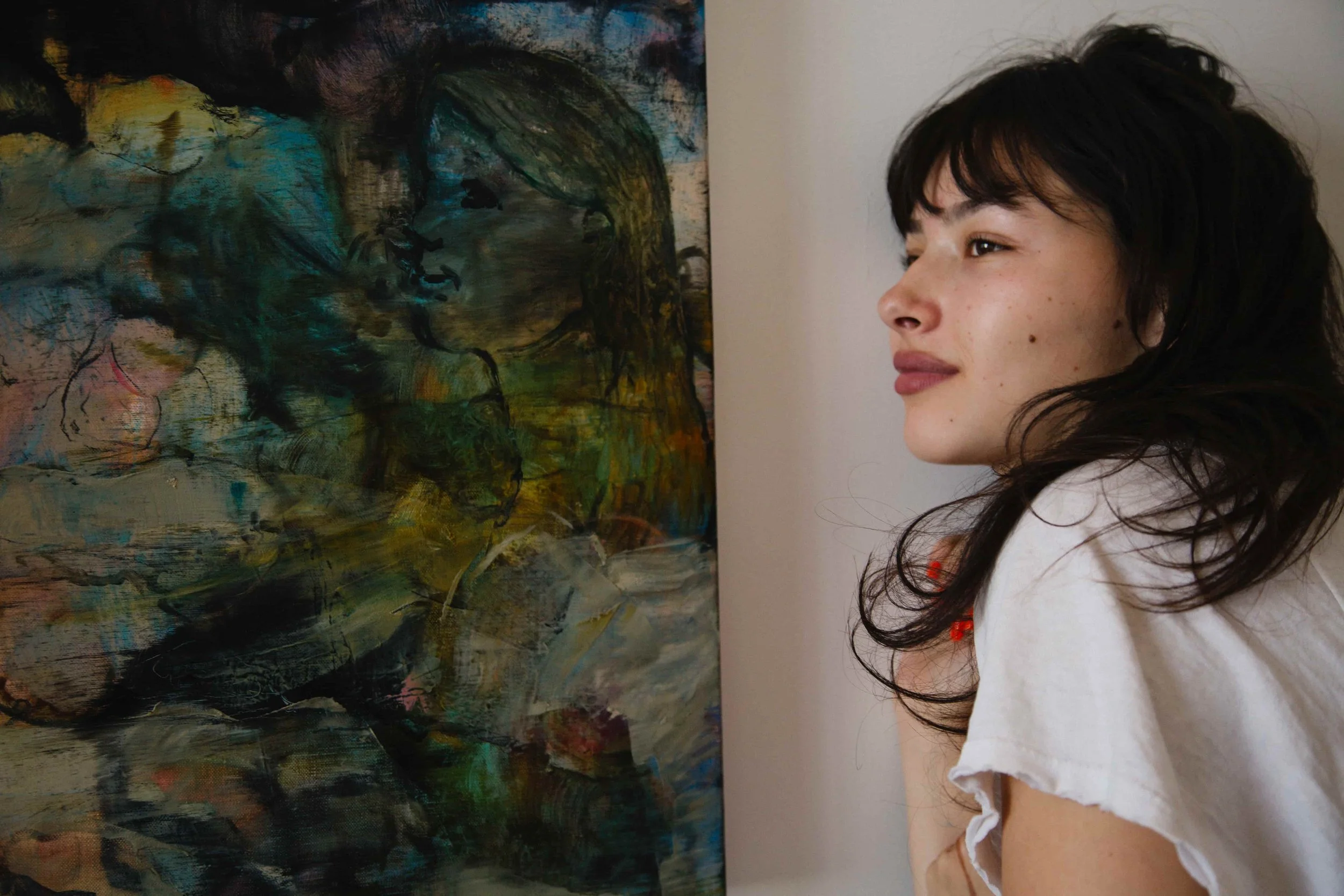Amber Wynne-Jones: A Body Among Many
Artist Amber Wynne-Jones traces how her childhood in the house music scene and an exacting talent for drawing led to her painting practice.
Words by CHARLOTTE SHELTON
Photography by NIKKI BURNETT
On a muggy July afternoon in Bushwick, artist Amber Wynne-Jones opens a non-descript door for me on the side of an industrial building. In a cut up shirt and basketball shorts, she leads me up the stairs to her new studio. On the second floor, we wind through a maze of temporary walls erected in the brutalist building, the sounds of various art practices floating over the low ceilings of her neighbors.
In her shared painting studio, with coveted north-facing windows, the young artist and I do a little dance around the space. A childhood photo hangs on the wall; a stack of art books, including Phillip Guston’s “I Paint What I Want to See,” rest on a table, dog eared and bookmarked. I’ve just missed her newly made works, which are hanging at John St Gallery in Brooklyn for a group show.
Amber’s artworks are borderless. Her paint floats across the canvas, creating images and shapes that breathe into one another. Looking at a work, one can always find a root image — typically a face or figure — in the layers of oil paint. Her loose strokes build upon themselves, transporting the viewer to a dream they once had, a recollection of sorts.
“Growing up, I was always drawing,” Amber tells me as we sit down on small stools in front of the fan. “It was always the thing I was good at.” Like many artists, Amber is gifted with the ability to have an idea and execute it in a drawing, exactly as she sees it in mind.
The oil painting came later, after her arrival in 2021 at Parsons School of Design in New York City. A monoprinting class offered her the chance to explore the materiality of oil, where she could manipulate and experiment with a forgiving and receptive medium. When first approaching the canvas, Amber brought her drawing mindset — one that is replicatory and imitative in nature. Every time she attempted to paint, she found herself lost, copying images from pictures or still life. “It was really difficult for me to bring my voice into painting,” she explains.
Eventually, a revelation came: painting has no end. “It has the ability to show all these layers at once,” she elaborates, highlighting the malleable nature of the medium. When working with oil paints, the artist has to move slowly, as each layer of application requires an extended period to dry. The practice requires a great deal of time and patience — more time than, say, drawing, which can happen instantly and without interruption. In those stretches, Amber finds a freedom to explore composition, form, and color.
Raised by a DJ and among the world of house music, Amber has been deeply immersed in a subculture that most people only discover in their teenage years. Her youngest memories are of music festivals, dancing in the packed crowds. “My first sensations were of being a body among many,” Amber reveals. These foundational experiences in lively, lyrical spaces are revealed in her paintings, each of which explore movement. Bodies on top of one another, climbing around, digging in the mud — these forms collide with one another in the layers of oil paint. While the subject matter changes, her work is ultimately about collectivity.
As a true daughter of the 21st century, the internet became her main creative outlet by the time she was a teenager. On Tumblr and Instagram, she had moodboard and anime drawing accounts with tens of thousands of followers. Social media opened up a platform for her to share her drawings and curate her taste.
Music, movement, and painting reached a perfect confluence for Amber in 2024, when she had the opportunity to create the cover art for Arca’s remix of Addison Rae’s, “Aquamarine.” Arca, the Venezuelan DJ who remixed the single, has served as a longtime inspiration for Amber, particularly in her celebrations of the divine feminine. The song marked an important moment for Addison, a declaration of her artistry — sensual, intriguing, mysterious — as she shed her old internet persona. The music video for “Aquamarine” announced Addison’s arrival as a serious artist, and one who could dance with a superb understanding of movement. Also working on the project was dancer Lexee Smith, a friend and frequent collaborator of Amber’s.
“I found the paintings [to be] a way to dive into myself,”
“It was a special project,” she says. “Energentically, I was able to make so much work from it. Very fun, very inspiring.”
While her education at Parsons provided the technical skills of fine art, Amber reached a point in her second year where she realized her classes wouldn’t teach her about art history or the traditions of painting. Taking it upon herself to get educated, she set about the galleries and museums in New York. This was pivotal. “I found the paintings [to be] a way to dive into myself,” she says, a shift away from the language of the internet in which she had become so fluent.
“In ‘I Paint What I Want To See’,” Amber tells me, picking up the 2022 title by Phillip Guston, a book that has been key in her self-guided education, “he talks about each painting having its own life.” For the master midcentury painter, each time he approached a new work, he had no idea what he was doing. Every artist feels this way, to an extent, including the ones Amber looks up to. This offers a bit of relief — comfort in knowing even the greatest artists get lost. Everyone reaches a point in a painting where they feel as though it’s the worst thing they’ve ever made. It is the act of resolution, in solving the problem of hating an artwork, that the magic happens.
She might begin with a sketch or reference in mind, but Amber finds freedom in seeing what comes out through the paint. This approach, as Amber describes it, allows for the painting to make itself. In this explanation of her process, I’m reminded of an evening earlier this summer with Amber and friend Lula Hawkins. “You were actually the inspiration for one of my paintings” she tells Lula, pulling up an Instagram post of a self-portrait her friend had taken. Amber began by sketching the photo of Lula laying in the grass, and layers upon layers of paint revealed something wholly unique. Side by side, we agree we can see where the painting started, though its final form has morphed into an entirely new image.
Amber and I glance at the unfinished painting on her wall, caught in between layers of sketching and drying paint. She doesn’t yet know how she will finish this one. “You have to let it unfold, and [allow] the painting to exist within itself.”





